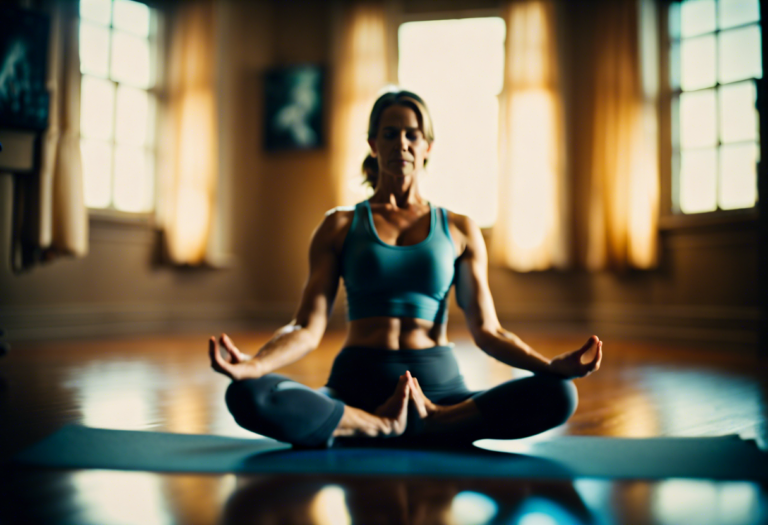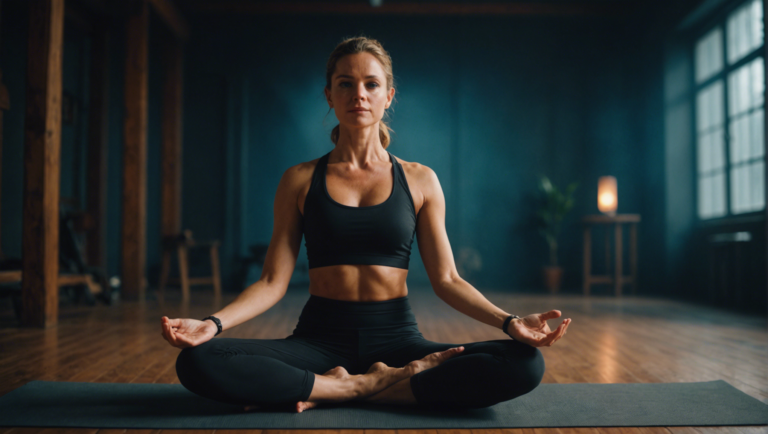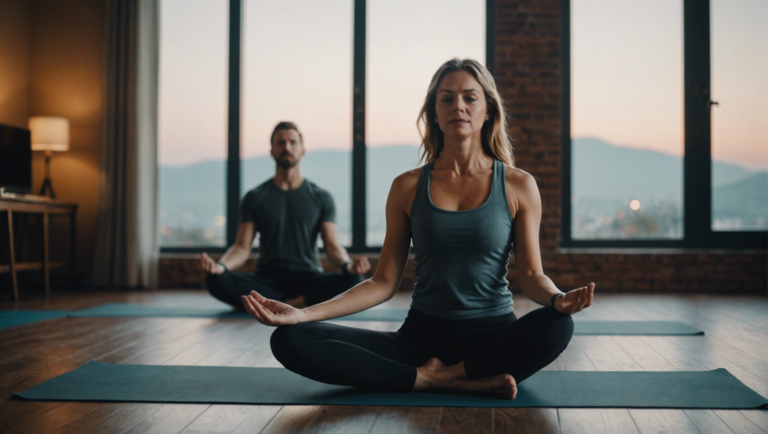Step-by-Step Guideline: Mastering The Jump Back In Yoga
Benefits of Mastering the Jump Back in Yoga
Mastering the Jump Back in Yoga brings numerous benefits to your practice, helping you improve strength, flexibility, and overall body awareness. This challenging move requires coordination, core strength, and mindfulness. Let’s explore the advantages of mastering the Jump Back in Yoga.
Increased Strength
Performing the Jump Back requires a significant amount of upper body strength, particularly in the arms, shoulders, and core. As you lower your body from a high plank position into Chaturanga Dandasana, you engage muscles throughout your body. With consistent practice, you’ll notice improvements in your overall strength, enabling you to flow through your vinyasas with greater ease.
Improved Core Stability
The Jump Back is an excellent exercise for strengthening your core muscles. Successfully executing this movement involves engaging your abdominal muscles to lift your hips and glide your feet back smoothly. Over time, you’ll develop better core stability, which is essential for maintaining proper alignment in various yoga poses and protecting your lower back from strain.
Enhanced Flexibility
Mastering the Jump Back requires a good degree of flexibility in the hip flexors, hamstrings, and shoulders. Regular practice of this transition can help increase your overall flexibility, making it easier to move in and out of other challenging poses. By incorporating the Jump Back into your yoga routine, you’ll gradually loosen tight muscles and improve your range of motion.
Mind-Body Connection
The Jump Back in Yoga is not just about physical strength and flexibility; it also demands mental focus and body awareness. To execute the movement smoothly, you must synchronize your breath with each step and maintain mindfulness throughout the transition. This deepens your mind-body connection, allowing you to stay present on the mat and cultivate a sense of calm and clarity.
Cardiovascular Benefits
The dynamic nature of the Jump Back creates a cardiovascular challenge, elevating your heart rate and promoting cardiovascular health. By incorporating this move into your practice, you can enjoy the benefits of a more cardio-intensive workout, enhancing your overall fitness level and stamina.
Mastery of Transitions
Mastering the Jump Back not only enhances your physical abilities but also improves your transition between poses. Learning how to flow seamlessly from one asana to another cultivates grace and fluidity in your practice. This skill translates beyond the mat, teaching you how to navigate life’s transitions with more ease and mindfulness.
Mastering the Jump Back in Yoga offers a multitude of benefits that extend beyond the physical realm. By incorporating this challenging transition into your practice, you can enhance your strength, flexibility, and overall mind-body connection. Embrace the journey of mastering the Jump Back and unlock a new level of growth and transformation in your yoga practice.
Common Mistakes to Avoid When Performing the Jump Back
Performing the jump back in yoga is a challenging and dynamic movement that requires strength, flexibility, and proper technique. While mastering this transition can greatly enhance your yoga practice, there are common mistakes that practitioners often make. By being aware of these pitfalls and learning how to avoid them, you can improve your jump back technique and prevent injuries.
Lack of Core Engagement
One of the most common mistakes when performing the jump back is a lack of engagement in the core muscles. Without a strong and stable core, it becomes difficult to lift the legs off the ground and transition smoothly from a seated position to a plank pose. To avoid this mistake, focus on engaging your core muscles before initiating the jump back. Practice strengthening exercises such as Plank Pose and Boat Pose to build core strength and stability.
Incorrect Hand Placement
Another common mistake is placing the hands too far back or too close to the body during the jump back. Improper hand placement can lead to instability and make it challenging to control the movement. To avoid this mistake, ensure that your hands are shoulder-width apart and positioned directly under your shoulders. This alignment provides a solid foundation for the jump back and helps maintain balance throughout the transition.
Lack of Shoulder Stability
Many practitioners overlook the importance of shoulder stability when performing the jump back. Weak or improperly engaged shoulder muscles can result in collapsing or sinking in the shoulders during the transition, putting strain on the joints. To avoid this mistake, focus on engaging the muscles around the shoulder blades and drawing them down your back. This action creates stability in the shoulders and helps to support the weight of your body as you move from a seated position to a plank pose.
Rushing the Movement
Trying to rush through the jump back is a common mistake that can compromise form and lead to injury. Moving too quickly without proper alignment and control can strain the wrists, shoulders, and lower back. To avoid this mistake, focus on moving mindfully and with intention. Slow down the transition, paying attention to proper alignment, breath control, and muscle engagement. Gradually increase your speed as you build strength and confidence in the movement.
Not Using the Breath Effectively
The breath is a fundamental aspect of yoga practice, and incorporating it into the jump back is essential. Many practitioners hold their breath or forget to coordinate breath with movement, which can disrupt the flow and rhythm of the transition. To avoid this mistake, focus on synchronized breathing—inhaling as you prepare for the jump back and exhaling as you lift your legs and move into plank pose. Conscious breathing not only enhances the fluidity of the movement but also helps you stay present and focused during the transition.
Mastering the jump back in yoga requires attention to detail, awareness of your body, and consistent practice. By avoiding these common mistakes and focusing on proper technique, core engagement, hand placement, shoulder stability, mindful movement, and coordinated breathing, you can improve your jump back skills and elevate your yoga practice to new heights.
Developing Core Strength for a Smooth Jump Back Transition
Breathing Techniques to Enhance Your Jump Back in Yoga
Progression Exercises to Help You Master the Jump Back
Mastering the jump back in yoga requires strength, flexibility, and technique. This advanced transition not only challenges your physical abilities but also demands focus and coordination. Progression exercises play a crucial role in building the necessary skills to execute a smooth and controlled jump back. By incorporating targeted movements into your yoga practice, you can enhance your overall performance and master this challenging skill.
Building Strength with Chaturanga Dandasana
Chaturanga Dandasana, also known as Four-Limbed Staff Pose, is a fundamental yoga pose that strengthens the arms, core, and shoulders – essential muscle groups for a successful jump back. Practicing Chaturanga regularly helps improve your upper body strength and stability, preparing you for the strength required to lift and move your body weight smoothly during the jump back.
Enhancing Flexibility Through Forward Folds
Forward folds are excellent for increasing flexibility in the hamstrings, hip flexors, and lower back – key areas involved in the jump back. Poses like Uttanasana (Standing Forward Fold) and Paschimottanasana (Seated Forward Bend) help lengthen and loosen tight muscles, allowing for a more fluid movement when transitioning from a standing position to a low plank during the jump back.
Core Activation with Boat Pose
Boat Pose, or Navasana, is a core-strengthening yoga posture that targets the abdominals and hip flexors. A strong core is essential for lifting and floating back with control in the jump back. Boat Pose into your practice helps engage and strengthen the core muscles, improving your ability to maintain stability and balance throughout the transition.
Practicing Jump Back Drills
Specific jump back drills can help you refine your technique and coordination for a successful jump back. Start by practicing half jumps or stepping back halfway from a standing position to Chaturanga. Focus on maintaining a straight back, engaging your core, and landing lightly to prevent strain on your wrists and shoulders. As you build confidence and strength, gradually work towards full jump backs with control and precision.
Mindful Transitions and Breath Awareness
Transitioning smoothly in yoga requires more than just physical strength – it also involves mental focus and breath awareness. As you work on mastering the jump back, pay attention to your breath and synchronize it with your movements. Inhale as you prepare for the transition, exhale as you jump back to Chaturanga, and continue to breathe mindfully throughout the sequence. This conscious breathing helps calm the mind, improve concentration, and enhance the flow of your practice.
Consistent Practice and Patience
Mastering the jump back in yoga is a challenging yet rewarding journey that requires consistent practice and patience. Rome wasn’t built in a day, and similarly, mastering advanced yoga transitions takes time and dedication. Celebrate small victories along the way, stay committed to your practice, and trust in your ability to progress steadily towards achieving the jump back with ease and grace.
Progression exercises are essential for developing the strength, flexibility, and technique needed to master the jump back in yoga. By incorporating targeted movements, building core strength, enhancing flexibility, and practicing mindful transitions, you can refine your skills and approach this advanced transition with confidence and proficiency. Remember, yoga is a personal practice, and progress is measured not by perfection but by your commitment to growth and self-improvement. Embrace the journey, enjoy the process, and trust in your ability to soar through your practice with grace and poise.
Conclusion
Mastering the jump back in yoga is a challenging yet rewarding feat that can significantly enhance your practice. By understanding the benefits of this advanced transition, avoiding common mistakes, developing core strength, utilizing proper breathing techniques, and incorporating progression exercises, you can elevate your yoga practice to new heights.
The benefits of mastering the jump back in yoga are multifaceted. Not only does it help to build upper body strength, but it also improves overall coordination and body awareness. As you become more proficient in executing the jump back, you’ll notice an increased sense of fluidity in your practice, allowing you to seamlessly flow from one pose to the next with grace and control.
In order to successfully master the jump back, it’s essential to be aware of common mistakes that can hinder your progress. Avoid collapsing in the shoulders, rounding the back, or relying solely on momentum to transition through the movement. By maintaining proper alignment and engaging the core muscles, you can avoid injury and progress more effectively in your practice.
Developing core strength is crucial for achieving a smooth jump back transition. By incorporating exercises that target the muscles of the abdomen, lower back, and pelvis, you can improve your stability and control during the movement. Planks, boat pose, and leg lifts are excellent exercises for strengthening the core and preparing your body for the demands of the jump back.
Breathing techniques play a significant role in enhancing your jump back in yoga. By synchronizing your breath with your movements, you can create a sense of ease and flow in your practice. Practice deep, full breaths as you initiate the jump back to center your mind and energize your body for the transition.
Progression exercises into your yoga routine can help you build the strength and flexibility necessary to master the jump back. Begin by practicing modified versions of the transition, such as stepping back one foot at a time or using yoga blocks for support. As you become more comfortable with the movement, gradually challenge yourself to perform the full jump back with control and precision.
By incorporating these tips into your practice, you can empower yourself to master the jump back in yoga and take your practice to the next level. Embrace the challenges, stay patient with yourself, and celebrate your progress along the way. With dedication and practice, you can enhance your yoga practice, cultivate mindfulness, and achieve a greater sense of well-being through mastering the jump back.



